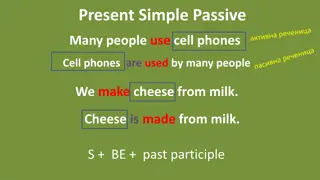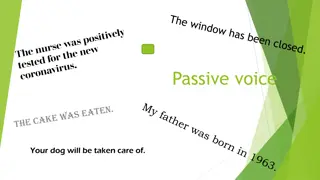Learn How to Form Passive Voice in English
Passive voice in English is formed using the verb "to be" and the Past Participle form of the verb. This article covers various tenses in passive voice with examples and images for better understanding.
Download Presentation

Please find below an Image/Link to download the presentation.
The content on the website is provided AS IS for your information and personal use only. It may not be sold, licensed, or shared on other websites without obtaining consent from the author.If you encounter any issues during the download, it is possible that the publisher has removed the file from their server.
You are allowed to download the files provided on this website for personal or commercial use, subject to the condition that they are used lawfully. All files are the property of their respective owners.
The content on the website is provided AS IS for your information and personal use only. It may not be sold, licensed, or shared on other websites without obtaining consent from the author.
E N D
Presentation Transcript
Autor: mgr Arleta Wygnalska Angielska stron biern (passive voice) tworzymy niemal e tak samo jak polsk , czyli za pomoc czasownika to be oraz formy Past Participle czyli trzeciej formy z tabelki. Strona bierna w okre lonych czasach b dzie wygl da :
Passive PresentSimple P+ (am, is, are) + III forma Active Passive - The shop is locked every day at 10 p.m. - They lock the shop every day at 10 p.m.
PassivePresentContinuous P+(am/is/are) being +III forma Active Passive Their homework is being done. They are doing their homework.
Passive Past Simple P+( was/were)+ III forma Active Passive The coffee was made. They made the coffee.
Passive Past Continuous P+(was/were) being +III forma Active Passive Dinner was being eaten when I came. They were eating dinner when I came.
Passive Present Perfect P+(have/has) been+III forma Active Passive It has been done. They have done it.
Passive Past Perfect P+had been+III forma Active Passive The money had been found. They had found the money.
Passive Future Simple P+ will be+ III forma Active Passive It will be done. I will do it.























